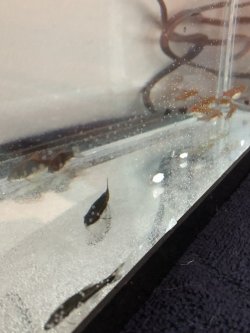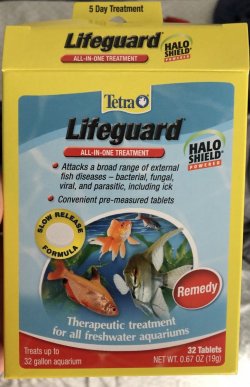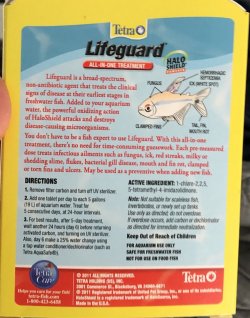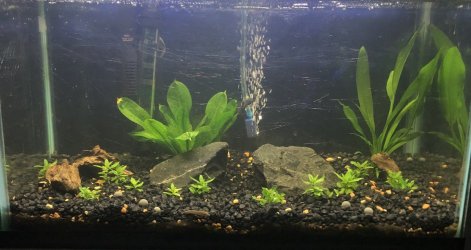The fungus cure will help fungus infection but won't help gill flukes if he has them. Treat with that for now and see how he does. @Colon_T, what do you suggest?
-
Guest, the Tank of the Year contest is underway!
💧 Which tank will win? 👉 View the entries and vote now!!
You are using an out of date browser. It may not display this or other websites correctly.
You should upgrade or use an alternative browser.
You should upgrade or use an alternative browser.
What disease is this!?!?! And what should I do!?!?!
- Thread starter Mateo Vanegas
- Start date
I really would appreciate it if people spelt my name correctly.Treat with that for now and see how he does. @Colon_T, what do you suggest?
Try a fungus treatment or salt and see what happens.
Kritastrophe
Fish Crazy
- Joined
- Jul 24, 2019
- Messages
- 224
- Reaction score
- 92
Maybe she had colon on her mind when she typed your name! 

Mateo Vanegas
Fish Fanatic
I’m going to Petsmart today to get some fungus cure
Mateo Vanegas
Fish Fanatic
Okay I just came back from PetSmart, I could not find fungus care, or any of the other stuff you guys told me to get but I did find this lifeguard all in one treatment, I have no time to order stuff online, I bought a 2.5 gallon tank, a heater and a filter and put all of my fish in there, they will be in there for 5 - 6 days maximum,I really would appreciate it if people spelt my name correctly.
Try a fungus treatment or salt and see what happens.
Oh yeah and also I went way over my 50$ maximum

Anything for my fish though

Attachments
Need to slow down here and focus.
No amount of medication is going to do any good if you do not get water quality under control.
The tank, for whatever reason is still not cycled, and need to do water changes as often as needed so that the fish are not exposed to ammonia. You do not do this ( water changes) when ammonia is detected, but before ammonia is detected. Once the fish are exposed its too late.
The issue with gills is a direct effect from ammonia toxicity. The gill filaments of fish are very fragile and they have been "burned" by ammonia toxicity, which allows secondary bacterial/fungal issues to take hold.
The Lifeguard is overkill- this is a med "bomb" that will do more harm than good.
This is a water quality and secondary bacterial/fungal issue. This is what you should be targeting. I would take the Lifeguard back and do the salt like was suggested along with a med that will take care of external bacteria. Look for an antibiotic that's active ingredient will deal with gram negative bacteria: kanamycin ( active ingredient in Seachem Kanaplex) or API's Triple Sulfa. Each of these are a better, more targeted choice than the Lifeguard.
.
Treatment:
While treating, do (minimum) 25% water changes between each dose of medication. If you are detecting any ammonia at all, you will need to increase the volume or frequency of these changes.
Non-iodized aquarium salt- use 1 teaspoon per 5 gallons of water. This is effective in healing gill tissues, reducing stress/ aiding osmoregulation in fish and works as an anti-bacterial. Use salt in water ( make sure to dissolve in tank-water/cup before dump in aquarium) for length of antibiotic treatment. When change water, add back salt to keep at consistent dose. .
Treat with either kanamycin or Triple Sulfa for full treatment.
No amount of medication is going to do any good if you do not get water quality under control.
The tank, for whatever reason is still not cycled, and need to do water changes as often as needed so that the fish are not exposed to ammonia. You do not do this ( water changes) when ammonia is detected, but before ammonia is detected. Once the fish are exposed its too late.
The issue with gills is a direct effect from ammonia toxicity. The gill filaments of fish are very fragile and they have been "burned" by ammonia toxicity, which allows secondary bacterial/fungal issues to take hold.
The Lifeguard is overkill- this is a med "bomb" that will do more harm than good.
This is a water quality and secondary bacterial/fungal issue. This is what you should be targeting. I would take the Lifeguard back and do the salt like was suggested along with a med that will take care of external bacteria. Look for an antibiotic that's active ingredient will deal with gram negative bacteria: kanamycin ( active ingredient in Seachem Kanaplex) or API's Triple Sulfa. Each of these are a better, more targeted choice than the Lifeguard.
.
Treatment:
While treating, do (minimum) 25% water changes between each dose of medication. If you are detecting any ammonia at all, you will need to increase the volume or frequency of these changes.
Non-iodized aquarium salt- use 1 teaspoon per 5 gallons of water. This is effective in healing gill tissues, reducing stress/ aiding osmoregulation in fish and works as an anti-bacterial. Use salt in water ( make sure to dissolve in tank-water/cup before dump in aquarium) for length of antibiotic treatment. When change water, add back salt to keep at consistent dose. .
Treat with either kanamycin or Triple Sulfa for full treatment.
Mateo Vanegas
Fish Fanatic
I should still use the salt, even though the glowlights are sensitive to salt?Need to slow down here and focus.
No amount of medication is going to do any good if you do not get water quality under control.
The tank, for whatever reason is still not cycled, and need to do water changes as often as needed so that the fish are not exposed to ammonia. You do not do this ( water changes) when ammonia is detected, but before ammonia is detected. Once the fish are exposed its too late.
The issue with gills is a direct effect from ammonia toxicity. The gill filaments of fish are very fragile and they have been "burned" by ammonia toxicity, which allows secondary bacterial/fungal issues to take hold.
The Lifeguard is overkill- this is a med "bomb" that will do more harm than good.
This is a water quality and secondary bacterial/fungal issue. This is what you should be targeting. I would take the Lifeguard back and do the salt like was suggested along with a med that will take care of external bacteria. Look for an antibiotic that's active ingredient will deal with gram negative bacteria: kanamycin ( active ingredient in Seachem Kanaplex) or API's Triple Sulfa. Each of these are a better, more targeted choice than the Lifeguard.
.
Treatment:
While treating, do (minimum) 25% water changes between each dose of medication. If you are detecting any ammonia at all, you will need to increase the volume or frequency of these changes.
Non-iodized aquarium salt- use 1 teaspoon per 5 gallons of water. This is effective in healing gill tissues, reducing stress/ aiding osmoregulation in fish and works as an anti-bacterial. Use salt in water ( make sure to dissolve in tank-water/cup before dump in aquarium) for length of antibiotic treatment. When change water, add back salt to keep at consistent dose. .
Treat with either kanamycin or Triple Sulfa for full treatment.
That is a very low dose of salt- the type of fish you have has been considered in that dose.
Yes, use the salt.
Yes, use the salt.
Mateo Vanegas
Fish Fanatic
Oh and also I have all of my fish in a 2.5 right now, so my 10 gallon is free, I will do 50% water changes every day before I go to work, until I get things cleared up, so I’m going to do a big water change right now clean everything up and watch the water conditionsNeed to slow down here and focus.
No amount of medication is going to do any good if you do not get water quality under control.
The tank, for whatever reason is still not cycled, and need to do water changes as often as needed so that the fish are not exposed to ammonia. You do not do this ( water changes) when ammonia is detected, but before ammonia is detected. Once the fish are exposed its too late.
The issue with gills is a direct effect from ammonia toxicity. The gill filaments of fish are very fragile and they have been "burned" by ammonia toxicity, which allows secondary bacterial/fungal issues to take hold.
The Lifeguard is overkill- this is a med "bomb" that will do more harm than good.
This is a water quality and secondary bacterial/fungal issue. This is what you should be targeting. I would take the Lifeguard back and do the salt like was suggested along with a med that will take care of external bacteria. Look for an antibiotic that's active ingredient will deal with gram negative bacteria: kanamycin ( active ingredient in Seachem Kanaplex) or API's Triple Sulfa. Each of these are a better, more targeted choice than the Lifeguard.
.
Treatment:
While treating, do (minimum) 25% water changes between each dose of medication. If you are detecting any ammonia at all, you will need to increase the volume or frequency of these changes.
Non-iodized aquarium salt- use 1 teaspoon per 5 gallons of water. This is effective in healing gill tissues, reducing stress/ aiding osmoregulation in fish and works as an anti-bacterial. Use salt in water ( make sure to dissolve in tank-water/cup before dump in aquarium) for length of antibiotic treatment. When change water, add back salt to keep at consistent dose. .
Treat with either kanamycin or Triple Sulfa for full treatment.
Attachments
Mateo Vanegas
Fish Fanatic
And tomorrow I’m going to Petsmart to get salt and stuff for the bacterial infectionOh and also I have all of my fish in a 2.5 right now, so my 10 gallon is free, I will do 50% water changes every day before I go to work, until I get things cleared up, so I’m going to do a big water change right now clean everything up and watch the water conditions
And thank you everyone for the help

That uncycled, 2.5 gallon tank is going to be very difficult to keep stable. Much more difficult than if you would have just left your fish in the 10 gallon and did regular water changes to ensure no ammonia/nitrite exposure.
Its good that you have a quarantine/hospital tank now that will be of use. But, you are going to have to be very vigilant that water quality doesn't go south in that small aquarium.
Its good that you have a quarantine/hospital tank now that will be of use. But, you are going to have to be very vigilant that water quality doesn't go south in that small aquarium.
Mateo Vanegas
Fish Fanatic
Ok in that case let me check the water nowThat uncycled, 2.5 gallon tank is going to be very difficult to keep stable. Much more difficult than if you would have just left your fish in the 10 gallon and did regular water changes to ensure no ammonia/nitrite exposure.
Its good that you have a quarantine/hospital tank now that will be of use. But, you are going to have to be very vigilant that water quality doesn't go south in that small aquarium.
I do it to get at him.Maybe she had colon on her mind when she typed your name!
Mateo Vanegas
Fish Fanatic
I looked and they did not have any, I’ll send a picture tomorrow to show
Similar threads
Most reactions
-
 348
348 -
 159
159 -
 141
141 -
 140
140 -
 139
139 -
 117
117 -
 110
110 -
 104
104 -
 96
96 -
 82
82 -
 71
71 -
 61
61 -
 56
56 -
 54
54 -
F
49





